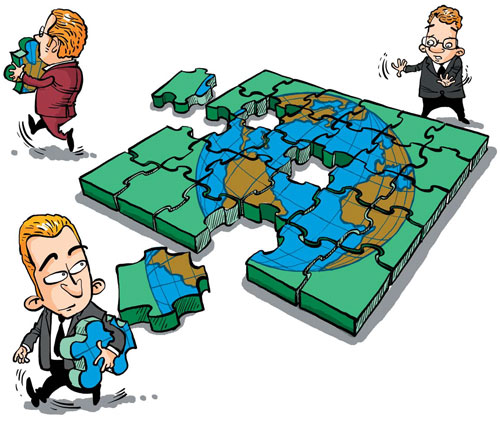We must resist de-globalization
Updated: 2011-05-20 10:34
By David Greenaway (China Daily European Weekly)
|
 |
Globalization is still an emotive word, but the phenomenon has been going on for centuries What have the Romans ever done for us? Well, they played their part.
China's Han Dynasty (206 BC-AD 220) was a crucial component of the same well-established trade network of 2,000 years ago, and now the country once again stands at the heart of the world economy.
But few nations know better than China that globalization can go backward as well as forward. Witness the 400 years of isolation before the sweeping economic reforms that have wrought such a dramatic transformation during the past three decades.
Now, quite suddenly, the threat of isolationism looms again. All over the world, bankers and investors have retreated to their domestic markets, driven back by the enervating effects of the global financial meltdown.
Two years ago, the Bank for International Settlements (BIS) released an alarming set of figures that revealed cross-border lending had plummeted by $4.8 trillion (3.37 trillion euros) in the nine months to December 2008. This was the most dramatic fall ever recorded.
Although its latest figures inevitably demonstrate a measure of recovery, the same institution recently warned that divergence between markets means there is greater uncertainty now than before what has become known as the Great Recession.
It was at around the same time that the record fall in cross-border lending was announced that China first floated the idea of a super-sovereign reserve currency to supplant the US dollar. As the once mighty wave of financial globalization receded, this represented a dramatic statement of intent from the world's emerging superpower.
To remind us this concept has by no means been forgotten, Xu Hong-cai, a deputy director at the China Center for International Economic Exchanges, recently produced a paper that called for an end to the dominance of the dollar in the interests of "stability and fairness". His call was publicized ahead of a G20 seminar at which China's own exchange rate was not up for discussion.
With confidence low and tensions high, it seems the only thing the credit crunch has helped to spread is fear. We find ourselves potentially teetering on the brink on an era of de-globalization - and that is a worrying prospect.
At this point it might be of benefit to reassure ourselves that the term "globalization", although it became widespread only in the latter part of the 20th century, is by no means a new occurrence.
Ancient Egypt's trade in the Near East might be considered an early example. More recognizably, the Silk Road between China and the Roman Empire and the efforts of traders and explorers during the Islamic Golden Age represent important landmarks in the process.
Fast-forward to the present day and we find a truly worldwide nexus of trade, technological and financial integration, investment and migration, embodied and exemplified by global organizations including the International Monetary Fund and the World Trade Organization. In some respects, the so-called death of distance is all but complete.
The criticisms of globalization are well known. Increased inequality, poverty and social exclusion, imbalances in economic power and double standards in international rules are regularly cited. They present challenges that have to be managed. However, they must be weighed against very real and tangible gains.
Globalization brings more efficient use of scarce resources, a greater and cheaper range of goods and services, reduced poverty, faster economic growth and rising living standards.
The last two of these benefits are clearly linked. Taking some random examples, we can easily demonstrate how even small differences in growth rates lead to large differences in living standards.
In 1900, the GDP per capita of Argentina and Austria was $2,765 and $2,882 a year. During the course of the next century their growth rates were 1.13 percent and 1.94 percent. By 2000, their GDP per capita was $8,544 and $20,077.
Looking at more recent success stories, both China and India had highly protective and inward-looking economies prior to the 1990s. Even by 1992 China's tariffs on imports averaged more than 40 percent and India's a prohibitive 90 percent. By 2008, China's average tariff was under 10 percent and India's under 30 percent.
To date, China, of course, has substantially outperformed India. Greater roles for foreign direct investment, export development and technology upgrading - all key elements of globalization - have been crucial to the disparity.
China's rise has become perhaps the defining story of globalization. More dramatically than any other nation, it has shown how increased globalization can lead to an increase in both the quantity and quality of available productive assets.
Globally, meanwhile, the numbers speak for themselves. Worldwide merchandise trade in 2005-2006 amounted to $11.8 trillion and services trade $2.7 trillion; foreign investment flows stood at $916 billion; and foreign investment stocks were worth $10.1 trillion.
A little over a year later, somewhere in the United States subprime mortgage market, the tide began to turn. Thanks to the credit crunch and the crippling dread it engendered, cross-border flows - in many ways the very lifeblood of globalization - all but seized up.
This was especially notable in the US, which suffered a $109 billion exodus of foreign capital in the final three quarters of 2008. In the previous nine months there was a $774 billion inflow.
For its own part, seemingly prompted by the rescue of Bear Stearns, the US repatriated $750 billion in the last three quarters of 2008. With domestic lending dominant, suddenly protectionism was very much back on the agenda - and the prospect endures in 2011.
Emerging markets in Europe and the former Soviet Union can expect to suffer particularly badly from this trend, since it is foreigners who own much of their banking systems. But nobody can expect to escape.
This was not how it was meant to be. Economic instability has always been a likely obstacle to globalization, but trade wars and the failure of WTO talks - not bad mortgages - have traditionally been viewed as the likely triggers.
Of course, we have learnt to expect the unexpected. In recent years alone the world economy has endured Sept 11, wars in Afghanistan and Iraq, SARS and the Asian tsunami - and globalization survived them all.
Similarly, it came through the collapse of the Bretton Woods system, the debt crisis of the mid-1970s, the oil shocks of 1973 and 1980, hyper-inflation, the fall of Communism in Europe and the Asian financial crisis. Now the Japanese earthquake, the so-called Arab Spring and widespread sovereign debt crises present new challenges.
De-globalization, like globalization, is hardly a new phenomenon. The economic chaos of the 1930s and the Soviet bloc in the aftermath of World War II are just two obvious instances of de-globalizing - and, indeed, the painful consequences it can bring.
It is almost impossible to imagine we will plumb such depths again. Even amid the current turmoil, globalization is very probably too far advanced, too entrenched, to allow that to happen.
It may well be, as many commentators have already pointed out, that the best we can expect pro tempore is to "muddle through"; and this, by common consent, is precisely what we have been doing. We can only hope it is the very least we manage - otherwise the repercussions will be felt far and wide and for years to come.
David Greenaway is a professor of economics and the founding director of the Leverhulme Centre for Research on Globalization and Economic Policy (GEP). GEP is based within the Nottingham School of Economics at the University of Nottingham, where Greenaway is vice-chancellor. On May 18, Zhejiang University's College of Economics hosted a GEP delegation for a joint workshop entitled Trade Costs, Economic Geography and Firm Heterogeneity.
E-paper

Green works
Wuxi becomes 'test case' for facing country's environmental challenges
Preview of the coming issue
The global rise of Chinese brands
China-EU trade on solid ground
Specials

The song dynasty
There are MORE THAN 300 types of Chinese operas but two POPULAR varieties are major standouts

Cut above the rest
One of the world's oldest surgeons has performed more than 14,000 operations

From the ground up
Architect of Guangzhou Opera House has many projects under way, including 2012 Olympics.
